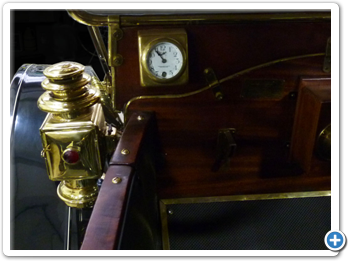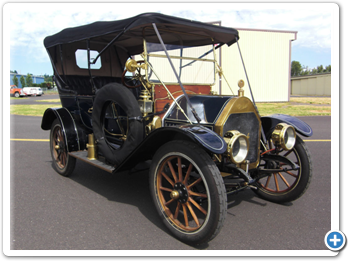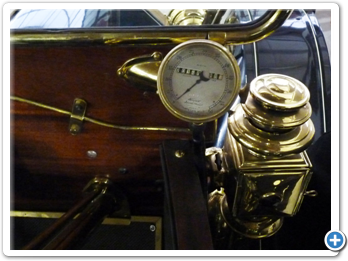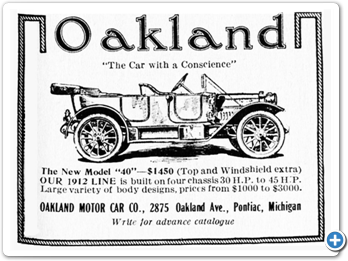|
Everyone knows that provenance (the origin and ownership history) adds value to a collector car, but how many owners take the time to do the necessary research and documentation of their vehicles?
Paul and Sharon Lawson set a fine example by connecting with their 1911 Oakland’s past, adding human interest to the vehicle and creating a historical archive subsequent generations will enjoy.
The Lawsons purchased the Oakland several years ago in San Diego after learning about it from a “questionable” character.
“We went on a Horseless Carriage Club tour, planning to buy a car,” said Sharon. “This fellow, wearing an overcoat and driving a Ford police car, had pictures of the Oakland on the inside of his overcoat, like he had a secret. He said it was owned by a widow with a lot of cars and it was time to get rid of some of them. We didn’t decide then, but soon after we saw it at the San Diego Qualcomm Stadium Swap Meet. We couldn’t come to an agreement on the price and were driving away when here comes the phone call! The vehicle had new paint, upholstery, and a new top, so we brought it back to the Northwest on a trailer behind our motor home. We had to do quite a bit of mechanical work on it but it runs fine now; we have taken it on several tours.”
In 2008, the Lawsons took the Oakland back where it was manufactured and to an Oakland 100th birthday party--both in Michigan--then to the city where it was first sold (Cedar Falls, Iowa).
“December 1907 was when the first Oakland was built, and 1908 was the first model year,” said Paul. “While we were in Michigan, we went to the Henry Ford Museum Old Car Festival at Greenfield Village in Dearborn and parked on the green. They have the festival once a year and there are hundreds of cars. In 2008, Oakland was their featured car.

“Then we went to Erie, Pennsylvania and visited some friends. We already had some information on the car: who owned it, starting in 1949 and continuing on to the late ‘50s and early ‘60s. We had a phone number for an owner in Cedar Falls, Iowa, so we drove there, arriving on a Saturday night. I called the number and it was still good, so I asked the lady who answered for her husband. She said he had died 11 years previously. I asked, ‘Did you have a 1911 Oakland in your family?’ She said, ‘Yes,’ so I told her we had the car with us and she said she wanted to see it. Her son was 10 years old when they sold the car and he used to make his allowance polishing the brass. He lived in Des Moines, about 100 miles away, so she called him and they met us the next morning. The son now has a family of his own with pre-teenage kids. We took pictures and later went to lunch and they told us what they knew of the car’s history. When the father sold the car in 1962, he wrote a letter with very detailed instructions on how to crank it. I showed it to them and gave them a copy. It was interesting meeting them and we have corresponded since then.”

After the Lawsons shared the happy fate of the Oakland with its previous owners, they set about discovering more of its history. While at the Oakland convention in Detroit, they saw a photograph of their car in a book about the history of the Pontiac-Oakland automobile. It had a picture of the car and a reference to an article that had appeared in Automobile Quarterly in 1950. They requested a reprint of that article from a local library and, after a couple of months, received it from a library in the eastern United States.
“It was written by the person who restored the car,” said Paul. “He said the car was rescued from a junk yard in 1949, in the same area where it was originally sold. It sat in the junk yard during World War II and the wheels had sunk six inches into the mud, which was frozen when he bought the car. They had to use an axe to cut the mud away so they could move it the car.

“That article’s author contacted the original owner who said he purchased the car new in Cedar Falls and drove it for three years. Then he bought a new car and took the back seat out of the Oakland. For over ten years he used daily to haul six milk cans from their dairy to a creamery, so it turned into a work truck. It was then retired to the junkyard where it sat, somehow surviving the scrap heap, a common fate during World War II. That restorer never said which town junkyard harbored the car, but we have it narrowed down to within 50 miles. We have a picture of it sitting in the junkyard with a grain elevator in the background. People we have become acquainted with in that area are trying to figure out where that elevator is. We know it is by a railroad and within 50 miles of Cedar Falls.”
The Lawsons have added the Automobile Quarterly article and the photos to the car’s historical archive, and their Oakland is all the more interesting because of its detailed provenance.
In addition to uncovering the Oakland’s past, the Lawsons are improving the car a little at a time.
“It has gas lights and we are still working on getting those working properly,” said Sharon. If we do happen to be out at night, we have a big 500 watt battery-operated lamp that we carry with us.”
And they are enjoying it fully, having taken it to several tours and shows.
“We took the Oakland to a car show at the Waterford retirement community in Vancouver, Washington last summer,” remarked Paul, “and they voted our car the best. The Oakland was the oldest car there and probably the only one older than them!”
|
|
| Click on any item below for more details at Amazon.com |
|

|

|
Michael W. R. Davis
General Motors: A Photographic History
Arcadia Publishing, Paperback, 1999-11-23 |
|
The General Motors Corporation was established in 1908 by William C. Durant, who combined the Buick, Oldsmobile, and Oakland companies and, later, Cadillac, to form GM. From the 1920s onwards, GM grew from a firm that accounted for about 10% of new car sales in the U.S. to become the largest producer of cars and trucks in the world. The peak of the company’s power and market dominance came in the 1960s, which proved to be the decade of change for the U.S. auto industry. With the introduction of federal safety regulations and control tailpipe emissions, GM’s position as the world’s largest industrial corporation changed. Its marketing strategy was undone by competitive challenges, and the business was never to be the same again. General Motors: A Photographic History explores the growth of the company in a series of over 200 black-and-white images. From the first assembly line to post-Second World War recovery, images from the world auto shows and the consequent re-organization of GM take the reader on an intriguing visual tour of a tremendously important era in the industrialization of America.
|

|
William Pelfrey
Billy, Alfred, and General Motors: The Story of Two Unique Men, a Legendary Company, and a Remarkable Time in American History
AMACOM, Hardcover, 2006-03-27 |
|
One industry has had more impact on life in America than any other before or since. This well-reviewed book provides the story of two men and one company at the start of it all. You couldn’t find two more different men. Billy Durant was the consummate salesman, a brilliant wheeler-dealer with grand plans, unflappable energy, and a fondness for the high life. Alfred Sloan was the intellectual, an expert in business strategy and management, master of all things organizational. Together, this odd couple built perhaps the most successful enterprise in U.S. history, General Motors, and with it an industry that has come to define modern life throughout the world. Their story is full of timeless lessons, cautionary tales, and inspiration for business leaders and history buffs alike. Billy, Alfred, and General Motors is the tale not just of the two extraordinary men of its title but also of the formative decades of twentieth-century America, through two world wars and sea changes in business, industry, politics, and culture. The book includes vivid, warts-and-all portraits of the legends of the golden age of the automobile, from “Crazy” Henry Ford, Ransom Olds, and Charles Nash to the brilliant but uncredited David Dunbar Buick and Cadillac founder Henry Leland.
|
|
|
The 1912 Oakland “Colonial Coupe” was billed as the “ultimate” in beautiful automobiles. The coupe body was interchangeable with the runabout body.
The Oakland Creed, as stated through the years, presented the following praiseworthy objectives:
To build at a fair price an automobile so sprightly as to uphold its owner’s pride; so competent as to arouse his genuine respect; so reliable as to win his deepest confidence; so economical as to serve his highest interest--this has been the purpose, is now the accomplishment and will continue to be the endeavor to which Oakland devotes the whole of its energies, its resources, its skills...
This was quite a lot to live up to, but the Oakland Company did a pretty fair job of translating into fact the high standards it had set itself.
The Oakland car was the ancestor of the present day Pontiac, which it preceded by 19 years. It had an interesting career. The first Oakland, a two-cylinder gasoline buggy, appeared in 1907 and was powered by an engine that rotated counterclockwise. The first Pontiac, a light six-cylinder job with modern refinements and an enclosed body, was introduced at the New York Automobile Show in January 1926.
The whole thing started back in 1893 with a carriage and wagon factory, incorporated as the Pontiac Buggy Company. One of its founders, Edward M. Murphy, was an organization genius of unusual drive. Toward the close of the century, Murphy realized that the new-born automobile trade was beginning to draw skilled carriage builders away from their jobs.
Murphy could plainly see the handwriting on the wall and decided to become an automobile manufacturer. His first plan was to assemble cars from purchased parts and so reduce manufacturing costs. But Alanson P. Brush, creator of the highly successful Brush Runabout, had designed a sample two-cylinder car for Cadillac, which that fastidious company did not seem to want. Murphy stepped in, tested the car and thought it satisfactory. He made an agreement with Brush to manufacture under license, and in August, 1907, formed the Oakland Motor Car Company. He started production with a capital of $200,000.
The first Oakland looked good enough but was a sales flop. Maybe the customers didn’t care about cranking their autos the opposite way around; but more likely this newcomer featured too many novelties, among which were a crankshaft balancer and coil suspension.
Undismayed, Murphy had the design revamped and the following year came out with another two-cylinder Model A two-passenger runabout, selling for $1,300. Powered by a rugged 20 hp engine, it was priced to cut the ground from under its competitors. This one the public liked and its approval was reflected in the sale of 491 Oaklands during 1908.
In 1909, a completely new four-cylinder 40 hp model was introduced. It was offered in three body styles, priced from $1,600. The factory turned out 735 cars that year. Then it was bought out by William C. Durant, who made it another General Motors Division.
Edward M. Murphy, sparkplug of the Oakland enterprise, died following the GM merger and just failed to witness a spectacular production rise one year later--2,124 units. This represented practically a 200 percent sales increase.
The outstanding Oakland for 1910 was the Model K five-passenger touring car, powered by a four-cylinder 40 hp engine and weighing 2,250 pounds. Priced at $1,700, it was an unbeatable value and was largely responsible for the increased sales. Nevertheless, Oakland gains could not help General Motors out of current economic difficulties. Over-rapid plant expansion and the acquisition of too many unproductive companies were to prove disastrous. Obsessed with the idea of hedging against any eventuality, William C. Durant had paid handsomely for a number of concerns whose only real assets were the possible value of their patents. General Motors--in the hole for $12,000,000, borrowed from the banks--but on condition that the adventurous Durant step down--which he did.

The Oakland Division, meanwhile, kept rolling out cars and making them better all the time. Sales for 1912 were well over 6,000 units and in 1913 reached a new peak of more than 8,600 units, representing gross receipts of over $10,000,000. Largely responsible for this was the introduction of the Model 35 runabout, a new and fast light four with an electric self-starter. Oakland’s first six-cylinder design--the Model 6-60 seven-passenger touring car, priced at a reasonable $2,400, also helped the Oakland Division’s reputation.
The new Oakland of 1915 included two models, each offered in two body styles--a roadster and a five-passenger touring car. The smaller, known as the Model 37, had a four-cylinder engine and a 112-inch wheelbase. The larger was the Model 6-49, a six-cylinder job with an Oakland-North way long-stroke engine, which was silent.
The following year, Durant’s financial magic regained him control of General Motors from the bankers.
Introduction of the Pontiac, ten years later, did not mean the end of the Oakland car. This fine make continued in parallel production with the newcomer, right on up to 1930-31, when the last Oakland was also the first V-8 in the low-priced field.
-- Revised from narrative by John Bentley
|
|
|